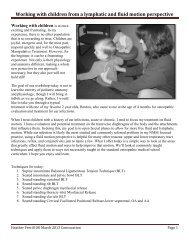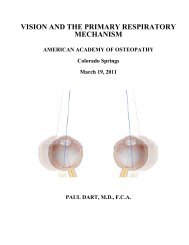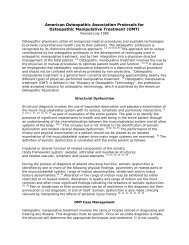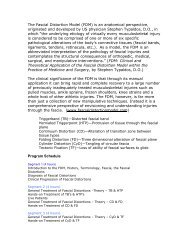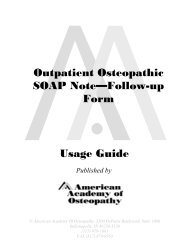EVALUATION AND MANAGEMENT
EVALUATION AND MANAGEMENT
EVALUATION AND MANAGEMENT
Create successful ePaper yourself
Turn your PDF publications into a flip-book with our unique Google optimized e-Paper software.
<strong>EVALUATION</strong> <strong>AND</strong> <strong>MANAGEMENT</strong>Coding and Documentation Reference Guide© CPT codes, descriptions, and other data only are copyright 2008 American MedicalAssociation. All rights reserved. Applicable FARS/DFARS clauses apply.1HISTORYHPI (History of Present Illness): Characterize HPI by considering either the Status of chronic conditions orthe number of elements recorded. 1 condition 2 conditions 3 conditionsOR Location Severity Timing Modifying factors Quality Duration Context Associated signs and symptomsROS (Review of Systems): Constitutional Ears, nose, GI Integumentary Endo(wt loss, etc.) mouth, throat GU (skin, breast) Hem/lymph Eyes Card/vasc Musculo Neuro All/immuno Resp PsychStatus of1–2 chronicconditionsBrief (1–3)N/AStatus of1–2 chronicconditionsBrief (1–3)Pertinent toproblem(1 system)Status of3 chronicconditionsExtended(4 or more)Extended(Pert and others)(2–9 systems)Status of3 chronicconditionsExtended(4 or more)Complete(Pert and allothers)(10 systems)PFSH (Past, Family, Social History): Past history (the patient’s past experiences with illnesses, operations, injuries and treatments) Family history (a review of medical events in the patient’s family, including diseases that may be hereditary orplace the patient at risk) Social history (an age-appropriate review of past and current activities)*Complete PFSH:2 history areas: a) established patients – office (outpatient) care, domiciliary care, home care;b) emergency department; c) subsequent nursing facility care; and, d) subsequent hospitalcare.3 history areas: a) new patients – office (outpatient) care, domiciliary care, home care;b) consultations; c) initial hospital care; d) hospital observation; and, e) initial nursing facilitycare.N/APROBLEM-FOCUSEDN/AEXP.PROBLEM-FOCUSEDPertinent(1 history area)DETAILEDFinal History requires all 3 componentsabove met or exceeded*Complete(2 or 3 historyareas)COMPREHENSIVE2EXAMINATIONCPT Exam Description 95 Guideline Requirements 97 Guideline Requirements CPT Type of ExamLimited to affected body area or organ system One body area or organ system 1–5 bulleted elements PROBLEM-FOCUSED EXAMAffected body area or organ system and other symptomatic orrelated organ systems2–7 body areas and/or organsystems6–11 bulleted elementsEXP<strong>AND</strong>EDPROBLEM-FOCUSED EXAMExtended exam of affected body area or organ system andother symptomatic or related organ systems2–7 body areas and/or organsystems12–17 bulleted elements for2 or more systemsDETAILED EXAMGeneral multi-systemComplete single organ system exam8 or more body areas and/ororgan systemsNot defined18 or more bulleted elements for9 or more systemsSee requirements for individualsingle system examsCOMPREHENSIVE EXAM3MEDICAL DECISION-MAKINGInstructions for Using TrailBlazer’s MDM Coding MethodCoding Medical Decision-Making (MDM) begins with separately coding the three distinct components of MDM. Two of the three components determine the final level of MDMcomplexity documented in a record of Evaluation and Management (E/M) service. These components are:1. Number of diagnoses and/or management options.2. Amount and/or complexity of data reviewed or ordered.3. Risk of complication and/or mortality.The TrailBlazer MDM coding method corresponds directly to the components above as follows:• Section A corresponds to number of diagnoses and/or management options.• Section B corresponds to amount and/or complexity of data reviewed or ordered.• Section C corresponds to risk of complication and/or mortality.Code each component separately using respective Tables A–C, then compare results from Tables A–C to requirements in Table D to determine the overall MDM level.Section ACoding Number of Diagnoses or Management Options – Use the Tables A.1 and A.2 on page 2 to determine the numbers of diagnoses or management options.Note: In all cases, the information in the clinical record (history and physical) must clearly support diagnostic impressions. Diagnostic impressions listed but not supportedelsewhere in the clinical record must not be included in the problem list for coding purposes.Revised September 2009 Page 1 Continued
3MEDICAL DECISION-MAKING (continued)Section CUse Table C.1 to determine the highest level or risk associated with each of the following: presenting problems, diagnostic procedure(s) ordered/performed, management options(s)chosen. Then use Table C.2 to determine the “final risk,” which is the highest of the three risks from Table C.1. The “final risk” from Table C.2 is used for Section D. Final Assignmentof Medical Decision Making Type.Table C.1 Risk of Complications and/or Morbidity or MortalityLevel of Risk Presenting Problem(s) Diagnostic Procedure(s) Ordered Management Options Selected• One self-limited or minor problem, e.g., cold,insect bite, tinea corporisMinimalLowModerateHigh• Two or more self-limited or minor problems• One stable chronic illness, e.g., wellcontrolledhypertension or non-insulindependent diabetes, cataract, BPH• Acute uncomplicated illness or injury, e.g.,cystitis, allergic rhinitis, simple sprain• One or more chronic illnesses with mildexacerbation, progression or side effects oftreatment• Two or more stable chronic illnesses• Undiagnosed new problem with uncertainprognosis, e.g., lump in breast• Acute illness with systemic symptoms, e.g.,pyelonephritis, pneumonitis, colitis• Acute complicated injury, e.g., head injurywith brief loss of consciousness• One or more chronic illnesses with severeexacerbation, progression or side effects oftreatment• Acute or chronic illnesses or injuries thatmay pose a threat to life or bodily function,e.g., multiple trauma, acute MI, pulmonaryembolus, severe respiratory distress,progressive severe rheumatoid arthritis,psychiatric illness with potential threat to selfor others, peritonitis, acute renal failure• An abrupt change in neurologic status, e.g.,seizure, TIA, weakness or sensory loss• Laboratory tests requiring venipuncture• Chest X-rays• EKG/EEG• Urinalysis• Ultrasound, e.g., echo• KOH prep• Physiologic tests not under stress, e.g.,pulmonary function tests• Non-cardiovascular imaging studies withcontrast, e.g., barium enema• Superficial needle biopsies• Clinical laboratory tests requiring arterialpuncture• Skin biopsies• Physiologic tests under stress, e.g., cardiacstress test, fetal contraction stress test• Diagnostic endoscopies with no identified riskfactors• Dee needle or incisional biopsy• Cardiovascular imaging studies with contrastand no identified risk factors, e.g., arteriogramcardiac cath• Obtain fluid from body cavity, e.g., lumbarprocedure, thoracentesis, culdocentesis• Cardiovascular imaging studies with contrastwith identified risk factors• Cardiac electrophysiological tests• Diagnostic endoscopies with identified riskfactors• Discography• Rest• Gargles• Elastic bandages• Superficial dressings• Over-the-counter drugs• Minor surgery with no identified risk factors• Physical therapy• Occupational therapy• IV fluids without additives• Minor surgery with identified risk factors• Elective major surgery (open, percutaneous orendoscopic) with no identified risk factors• Prescription drug management• Therapeutic nuclear medicine• IV fluids with additives• Closed treatment of fracture or dislocationwithout manipulation• Elective major surgery (open, percutaneous orendoscopic with identified risk factors)• Emergency major surgery (open,percutaneous or endoscopic)• Parenteral controlled substances• Drug therapy requiring intensive monitoring fortoxicity• Decision not to resuscitate or to de-escalatecare because of poor prognosis.Table C.2 Risk of Complication and/or Mortality (see Table C.1)Nature of the presenting illness Minimal Low Moderate HighRisk conferred by diagnostic options Minimal Low Moderate HighRisk conferred by therapeutic options Minimal Low Moderate HighFinal Risk determined by highest of 3 components aboveSection DFinal Assignment of Medical Decision Making Type1. Line A – Use Total Diagnosis Points or the Total Management Option Points from Section A (Tables A.1 and A.2).2. Line B – Use Total Points from Section B (Table B).3. Line C – Use highest level of risk from Section C (Table C.2).4. Choose final Type of Medical Decision Making. Final Type Requires 2 of the 3 MDM Components below be met or exceeded.Table D Final Assignment of Medical Decision Making TypeA. Number of diagnoses or management options 1 Point – Minimal 2 Points – Limited 3 Points – Multiple >4 Points – ExtensiveB. Amount and complexity of data reviewed/ordered 4 Points – ExtensiveC. Risk Minimal Low Moderate HighType of medical decision-making Straightforward Low Complexity Moderate Complexity High ComplexityFinal Medical Decision-Making requires 2 of 3 components above met or exceededRevised September 2009 Page 3 Continued
4LEVEL OF SERVICEHistoryExaminationComplexity ofMedical DecisionOUTPATIENT, CONSULTS (OUTPATIENT <strong>AND</strong> INPATIENT) <strong>AND</strong> ERNew Office/Consults/ERPFER: PFPFER: PFSFER: SFEPFER: EPFEPFER: EPFSFER: LRequires 3 components within shaded areaDER: EPFDER: EPFLER: MCER: DCER: DMER: MCER: CCER: CHER: HMinimalproblemthat maynot requirepresenceofphysicianEstablished OfficeRequires 2 components within shaded areaPF EPF DCPF EPF D CSF L M HAverage Time 10 New (99201) 20 New (99202) 30 New (99203) 45 New (99204) 60 New (99205)(minutes)(ER has noaverage time)15 Outpt cons (99241)20 Inpat cons (99251)ER (99281)30 Outpt cons (99242)40 Inpat cons (99252)ER (99282)40 Outpt cons (99243)55 Inpat cons (99253)ER (99283)60 Outpt cons (99244)80 Inpat cons (99254)ER (99284)80 Outpt cons (99245)100 Inpat cons (99255)ER (99285)5(99211)10(99212)15(99213)25(99214)Level I II III IV V I II III IV VINPATIENTInitial Hospital/ObservationRequires 3 components within shaded areaSubsequent Inpatient/Follow-upRequires 2 components within shaded areaHistory D or C C C PF interval EPF interval D intervalExamination D or C C C PF EPF DComplexity ofMedical DecisionSF/L M H SF/L M HAverage Time(minutes)(Observation carehas no averagetime)30 Init hosp (99221)Observ care (99218)50 Init hosp (99222)Observ care (99219)70 init hosp (99223)Observ care (99220)40(99215)15 Subsequent (99231) 25 Subsequent (99232) 35 Subsequent (99233)Level I II III I II IIINURSING FACILITYAnnual Assessment/AdmissionOld Plan Review New Plan AdmissionRequires 3 components within shaded areaSubsequent Nursing FacilityRequires 2 components within shaded areaHistory D/C C C PF interval EPF interval D interval C intervalExamination D/C C C PF EPF D CComplexity ofMedical DecisionSF M M SF L M HNo Average TimeEstablished(Confirmatoryconsults and ER(99304) (99305) (99306) (99307) (99308) (99309) (99310)have no averagetime)Level I II III I II III IVDOMICILIARY (REST HOME, CUSTODIAL CARE) <strong>AND</strong> HOME CARENewRequires 3 components within shaded areaEstablishedRequires 2 components within shaded areaHistory PF EPF D C C PF interval EPF interval D interval CExamination PF EPF D C C PF EPF D CComplexity ofMedicalDecisionAverage Time(minutes)SF L M M H SF L M H20 Domiciliary(99324)30 Domiciliary(99325)45 Domiciliary(99326)60 Domiciliary(99327)75 Domiciliary(99328)15 Domiciliary(99334)25 Domiciliary(99335)40 Domiciliary(99336)20 Home care(99341)30 Home care(99342)45 Home care(99343)60 Home care(99344)75 Home care(99345)15 Home care(99347)25 Home care(99348)40 Home care(99349)Level I II III IV V I II III IV60 Domiciliary(99337)60 Home care(99350)PF = Problem focused • EPF = Expanded problem focused • D = Detailed • C = Comprehensive • SF = Straightforward • L = Low • M = Moderate • H = HighRevised September 2009 Page 4




